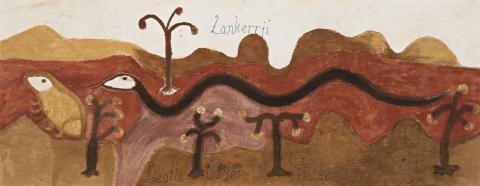LANKERRJI – DEATH ADDER SNAKE, 1987
GEORGE MUNG MUNG
ochres and bush gum on canvas
90.0 x 230.0 cm
bears inscription on the surface of the painting: Lankerrji / Death Adder Snake
bears inscription verso: No. 56 / A122
Painted at Warmun (Turkey Creek), Western Australia
Lord McAlpine of West Green
Sotheby's, Melbourne, 29 July 1990, lot 176
Private collection, Melbourne
Sotheby's, Melbourne, 24 July 2007, lot 120
The Luczo Family Collection, USA
A prominent cultural leader and elder of the Gija people, George Mung Mung was one of the first artists at Warmun (Turkey Creek) to paint the boards carried in the Gurirr Gurirr (Krill Krill) ceremonies that described the destruction of Darwin by Cyclone Tracy, as revealed to Rover Thomas. Mung Mung was also among the first group of artists at Warmun to paint consistently for the public domain, developing a distinctive style of painting that incorporated both planar and profile views of the landscape as well as figurative imagery as seen in paintings such as Jirling the Hunter, 1989, in the collection of the National Gallery of Victoria, and Binoowoon Country, 1990, in the collection of the National Gallery of Australia.1 In other paintings, figures of ancestral beings merge into features of the landscape.
Lankerrji – Death Adder Snake, 1987 is, however, composed in a more overtly literal manner –although the rhythmic form of the snake echoed in the profile of the hills in the background infers a type of metamorphosis. Mung Mung, along with a number of other prominent local artists including Rover Thomas and Rusty Peters (born 1935), painted works on board and canvas intended as learning aids for the Gija students at the school at Warmun. The inscription in this painting, in a hand that is not that of the artist, suggests that it was originally made for the school before it passed into the collection of the late Lord McAlpine, an avid collector of the art of the Kimberley.
WALLY CARUANA
1. See Ryan, J. and K. Akerman, (eds.), Images of Power: Aboriginal Art of the Kimberley, National Gallery of Victoria, Melbourne, 1993, p. 48, and Caruana, W., Aboriginal Art, World of Art Series, Thames and Hudson, London and New York, 2012, pl. 157, p. 180
